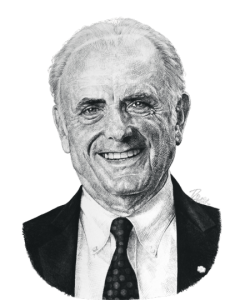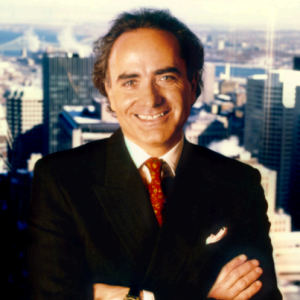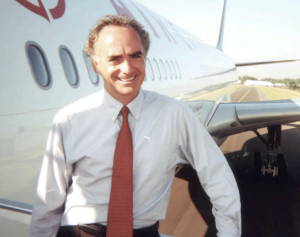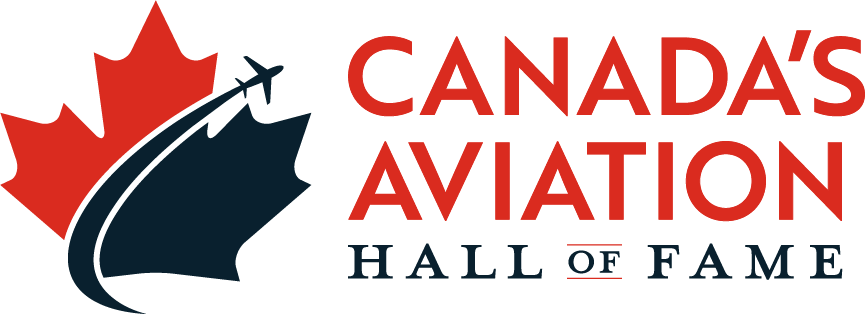Calin Rovinescu

Birth Date: September 16, 1995
Birth Place: Romania
Year Inducted: 2025
For his ongoing contributions to Canadian aviation, most notably for his work with and successful leadership of Air Canada during multiple periods of upheaval, Calin Rovinescu was inducted into Canada’s Aviation Hall of Fame in 2025.
Over a nearly forty-year period working with and then leading Air Canada, Calin Rovinescu has helped to transform the business of aviation in Canada.
Born in Romania to highly educated professionals, Calin’s family immigrated to Canada when he was a young boy. He was raised in Montreal and earned his CEGEP from McGill University, before completing law degrees om University of Montreal (1978) and University of Ottawa (1980).
After becoming a member of the Quebec and the Ontario Bars, Calin joined Stikeman Elliott, where he practiced corporate law for over twenty years, focusing on mergers and acquisitions, securities regulation, corporate finance, and privatizations. By 1985, he was a partner in the firm and would eventually lead its London office before returning to Montreal as Managing Partner in 1996.

Introduction to aviation: Air Canada
Calin’s introduction to aviation was largely through Air Canada. He served as lead external counsel on its privatization and public offering in 1988, the very first of several complex privatizations of Canadian Crown corporations, and continued advising the airline on significant transactions and events thereafter. A decade later, in 1999, while still at Stikeman Elliott, he worked closely with Robert Milton, then Air Canada’s CEO, to lead the company’s defence against a hostile takeover bid by Onex Corporation, American Airlines, and Canadian Airlines. The successful response deployed multiple legal, financial, communications, and alliance strategies; after ONEX withdrew its bid, Canadian Airlines was acquired by Air Canada. Calin joined the airline in 2000 as its Executive Vice President of Corporate Development and Strategy.
As if fending off a hostile bid from formidable opponents was not enough of a challenge, Air Canada soon faced new trials in quick succession at the beginning of the new millennium. First, the 1990s tech bubble burst causing enormous economic and financial damage to many corporations, especially airlines. Then, in 2001, was the shock to the airline industry following the horrific terror attacks of September 11. The third came in 2003 with the outbreak of the SARS virus that heavily affected Air Canada’s hub in Toronto, the second most affected city after Hong Kong. These events, coupled with the introduction within the industry of new low-cost carrier models, severely undermined Air Canada’s profitability, and it was soon facing financial difficulty, with significant losses through 2002. Its position was further encumbered by burdensome contracts assumed during the acquisition of Canadian Airlines, high labour costs, and onerous pension and other obligations. Moreover, most of the major U.S. carriers, including U.S. Airways, AirTran, Northwest, Delta, United, and American Airlines, were filing for Chapter 11 Bankruptcy protection to reduce their overhead and cost structure in the aftermath of September 11, making them more competitive.
Air Canada’s Board determined that the best course of action, to both reduce its cost structure, and deal with onerous contracts while staying competitive with the U.S., was to file for CCAA bankruptcy protection. It did so on 1 April 2003. Milton and Air Canada’s Board tasked Calin with heading the airline’s restructuring as its Chief Restructuring Officer in addition to his other responsibilities.
During the next twelve months of hard-fought negotiations, the company’s debt was entirely re-negotiated, all aircraft leases were restructured, new arrangements were entered into with all labour groups and their unions, new supplier arrangements were concluded, new contracts were signed with the company’s regional carriers, and multi- billion-dollar debtor-in-possession financing and equity sponsor deals were concluded. Several businesses including Aeroplan, Jazz, and AC Heavy Maintenance were spun off. The restructuring process, required by law to be Court-supervised and involving dozens of stake-holders and their lawyers, was tortuous and included many twists and turns over its course. Calin likened it to “playing full-contact, multi-dimensional chess in a fishbowl”, for everyone to read about in the morning papers. Yet through this difficult process Air Canada took a major step towards becoming more competitive and accountable.


For five years Calin took a break from aviation. In late 2004, he was a co-founder and principal of independent investment bank Genuity Capital Markets, which subsequently merged with Canaccord Capital to form Canaccord Genuity Group, Canada’s largest independent investment bank.
Air Canada convinced him to return in April 2009, when he was appointed to succeed Montie Brewer as President and CEO. The airline was facing yet another existential challenge: the aftermath of the 2007-08 global financial crisis, the so-called Great Recession, which lasted well into 2009. Stock markets had crashed, and banks were not lending, especially to airlines. The industry was rocked by sky-high fuel prices and across the board belt-tightening that included leisure and business air travel. Air Canada was further hampered by having higher operating costs compared to its primary Canadian LCC rival as well as a $4 billion defined benefit plan pension deficit. Moreover, all of the company’s labour contracts were up for renewal, the first time since 2003-04. It was a perfect storm, a wildly burning platform.
Over the course of his first year at the helm, Calin and his management team began putting out fires while setting Air Canada on a new course. They reached agreements with the company’s unionized workers and secured a moratorium on special payments to reduce its sizeable pension deficit. Calin and his team also started to rebuild the airline’s cash reserves, quickly raising more than $1 billion in liquidity, to improve future maneuverability. And it signed new or amended agreements with many of its major creditors, vendors, and suppliers – moves that included renegotiated or new Capacity Purchase Agreements with its primary regional operator, Jazz, then led by Joseph Randell (CAHF, 2020) as well as with an additional regional operator, Sky Regional, led by Russell Payson (CAHF, 2022).
Looking towards the future, Calin pushed to fashion Air Canada into becoming a truly global carrier – expanding its international route network, reforming the airline’s cost structure, and re-engaging with its customers, especially business travellers, all while fostering a more entrepreneurial culture across the company and its workforce. A key marker of this re-invigoration and cost focus was launch of a new budget carrier: Air Canada Rouge. Another highly strategic move was the company’s re-purchase of Aeroplan, which it had sold while needing liquidity back in 2004. Adopting a newer, more efficient fleet, was yet another a key piece underpinning Calin’s renewal strategy. These aircraft included Boeing 777s, 787s, and the 737MAX. In February 2016, Air Canada also signed a letter of intent to purchase the Bombardier C-Series aircraft. It was a strategically important decision for the airline, for Bombardier, and indeed for the entire Canadian aerospace industry. Alain Bellemare, Bombardier’s CEO, personally worked closely with Calin to complete the $3.8 billion order for the innovative design, thereby enabling the program to survive long enough for other key orders, including om Delta Airlines, to come in. In an appropriate nod to his role in acquiring the rechristened A220, the first aircraft to wear Air Canada’s livery was C-GROV, with Calin’s signature adorning its fuselage under the captain’s window.
Calin is broadly credited with having saved Air Canada om bankruptcy and with setting it on a course for sustainable profitability, better labour relations, and continued success. In the ten years following his appointment as CEO, the airline’s shares appreciated more than 4,000% and the company achieved record revenues, record profitability, and carried a record number of passengers, exceeding fifty million; over this period its common shares also had the greatest share price appreciation of those listed on the Toronto Stock Exchange. As a further part of this growth, Air Canada expanded dramatically, eventually serving 220 destinations on all continents. In recognition of this success, the airline was named by Skytrax as the best in North America in eight out of ten years, and as the only four-star network carrier in North America. In addition, it won numerous other awards, including Air Transport World's Eco Airline of the Year, while being repeatedly declared one of Canada's Top Employers.
In 2012, Calin was elected chairman of the Star Alliance chief executive board, the controlling body of Star Alliance (the world's largest global airline alliance) and he served in the role until 2016. From 2010 onwards, he was also a member of the board of governors of the International Air Transport Association, representing some 240 airlines; and he served as chairman of IATA om June 2014 to June 2015.
The broader business community in Canada took notice of this success. Report on Business magazine named Calin best CEO in 2013 (he would receive the honour again in 2019, making him the award’s only two-time winner). In 2016, he was named Canada’s Outstanding CEO of the Year by Financial Post Magazine. The Governor General of Canada appointed Calin a member of the Order of Canada in 2018 for promoting the associated charitable causes and organizations of Canada's largest airline, and for his leadership in spearheading humanitarian relief following several natural global disasters. In 2021, he was inducted into the Canadian Business Hall of Fame.
Calin had planned to retire in 2020 on turning sixty-five, having accomplished much. The COVID-19 pandemic changed this. He stayed on, providing steady, experienced leadership that helped to see one of Canada’s most storied airlines through yet another crisis, positioning it for many more years of global leadership in the future.
Since retirement, in addition to serving on the boards of several of Canada’s largest corporations, Calin has also stepped back into aviation, being recently named the Executive Chairman of CAE Inc., another Canadian global champion that has been led for over fifteen years by Marc Parent (CAHF, 2022).
Calin Rovinescu’s 2025 Induction
To return to the Inductee Page, please click here.
